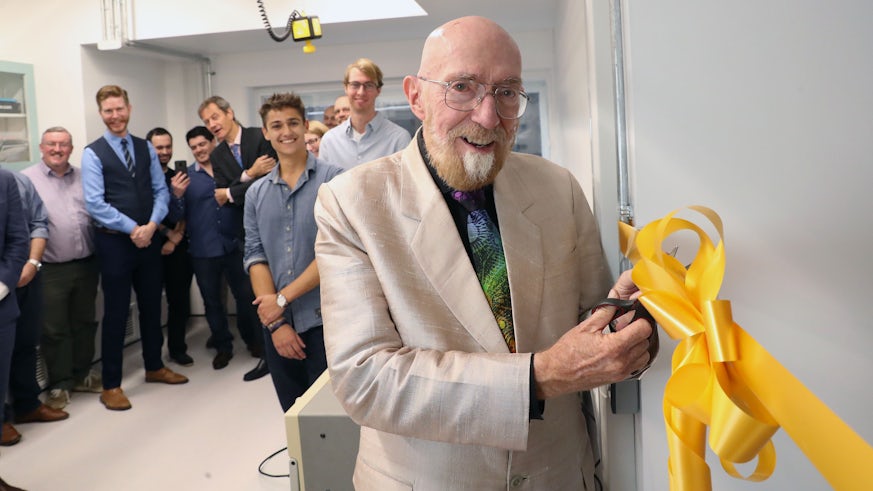Nobel Prize-winner Kip Thorne opens new Cardiff physics lab
22 October 2019

The Nobel Prize-winner Kip Thorne has visited Cardiff to open a brand-new gravitational physics lab.
The American scientist, one of three to be awarded the Nobel Prize in 2017 for the observation of gravitational waves, was given a tour of the new facilities that have been designed to enhance a project that Thorne co-founded over 30 years ago.
Thorne, who is the Feynman Professor of Theoretical Physics, Emeritus at the California Institute of Technology, is one of the world’s leading experts on the implications of Einstein’s general theory of relativity.
A long-time friend and colleague of Stephen Hawking and Carl Sagan, Thorne is also a scientific consultant who has worked on films including Christopher Nolan’s Interstellar.
In 1984 he co-founded the Laser Interferometer Gravitational Waves-Observatory (LIGO) which set out to observe a crucial piece of evidence proposed by Einstein’s famous theory – the existence of gravitational waves.
These tiny ripples in space-time, first proposed by Einstein over 100 years ago, are emitted as a result of violent cosmic events such as the collision of black holes.
Cardiff University scientists were founding members of the LIGO Scientific Collaboration and have made key contributions to the initial observation of gravitational waves in 2015 and the subsequent detections thereafter.
Research undertaken at Cardiff University has laid the foundations for how we go about detecting gravitational waves with the development of novel algorithms and software that have now become standard search tools for detecting the elusive signals.
The Gravity Exploration Institute is now expanding from the theoretical to the practical by helping to develop the next generation of detector technologies.

Gravitational wave detectors consist of kilometre-long, L-shaped tunnels through which a laser beam is bounced back and forth between mirrors, placed at opposite ends of each arm. Scientists look for signs of a gravitational wave entering the detectors by looking for a tiny mismatch in the time it takes each laser beam to complete its journey.
“Our new lab is dedicated to research and development of techniques to increase the sensitivity of existing and future gravitational wave detectors,” said Professor Hartmut Grote of the Cardiff University Gravity Exploration Institute.
“With more sensitive detectors, we can 'listen' to more colliding black holes and neutron stars, but our research will also serve to address other areas of fundamental physics, such as the search for high-frequency gravitational waves, dark matter, and ultimately the quantization of space-time.”
Thorne was accompanied on his tour of the new labs by Cardiff University’s Professor Bernard Schutz, who was mentored and supervised by Thorne when undertaking his PhD at Caltech.
Professor Schutz said: “I remember Kip visiting Cardiff in 1987 for the first-ever international conference on how to do data analysis for the then-planned detectors, one of many aspects of the detection effort that he took a deep and creative interest in.
“It’s fantastic that over three decades later, and with many gravitational waves detections now under our belt, we’ve been able to invite Kip back to Cardiff to see how the next generation of detectors will be developed.”
https://www.youtube.com/watch?v=P2GXna1psOo&feature=youtu.be





